#Neither of these mechanics really have just one thing they can be flavor wise
Explore tagged Tumblr posts
Text
Black commons


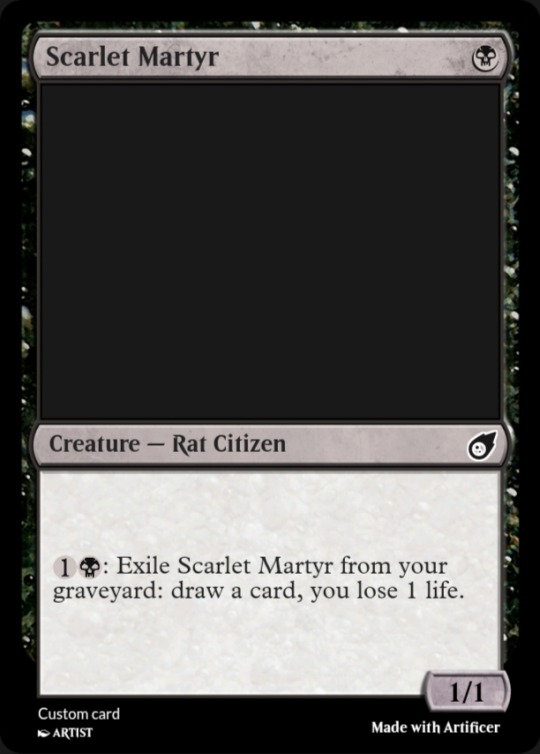
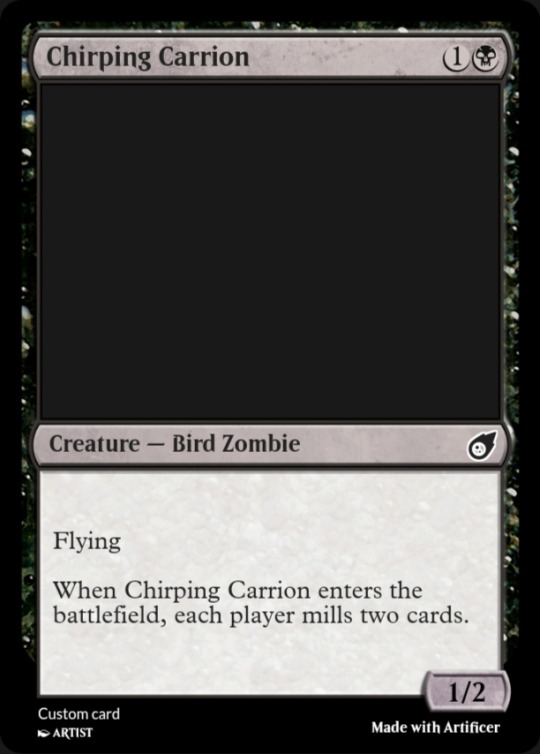
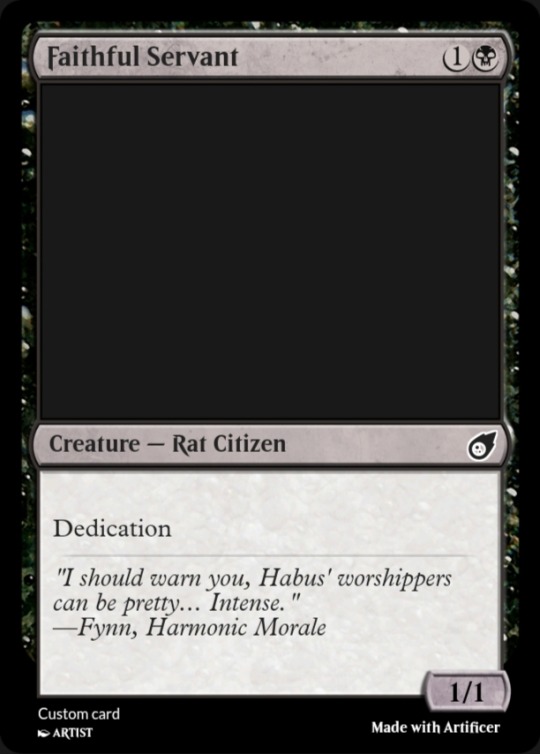
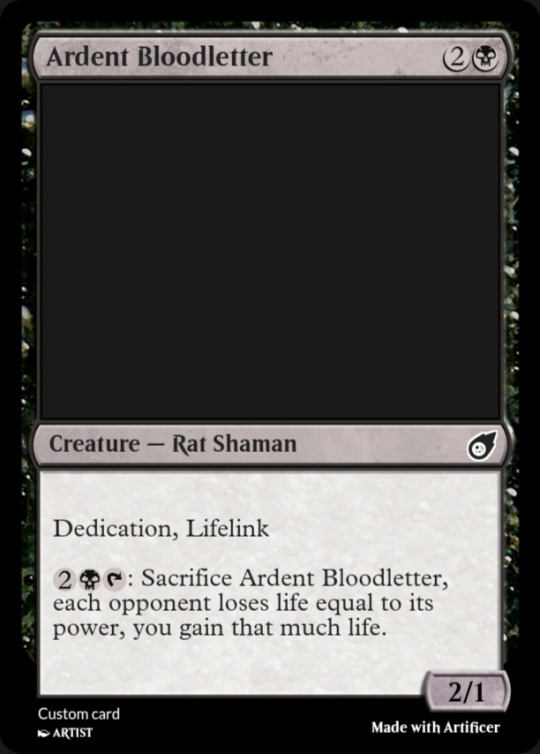
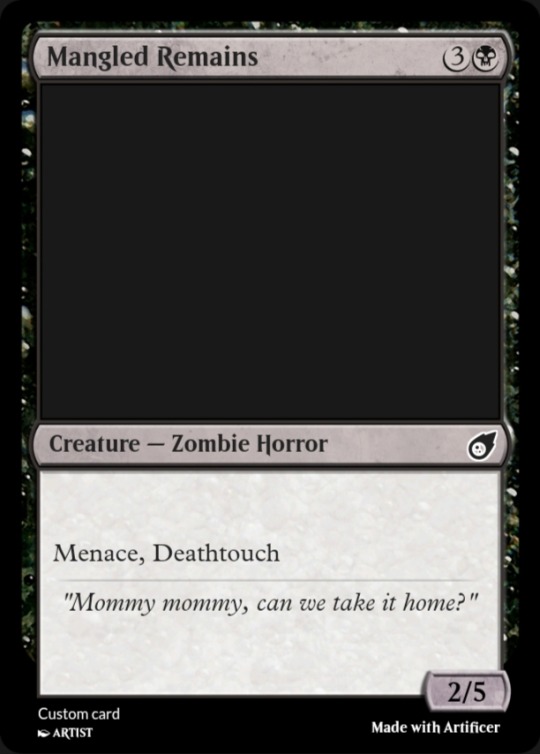
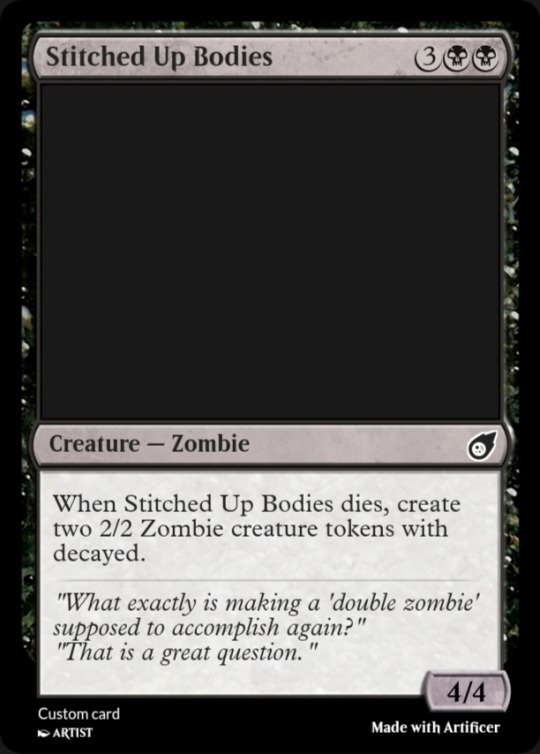
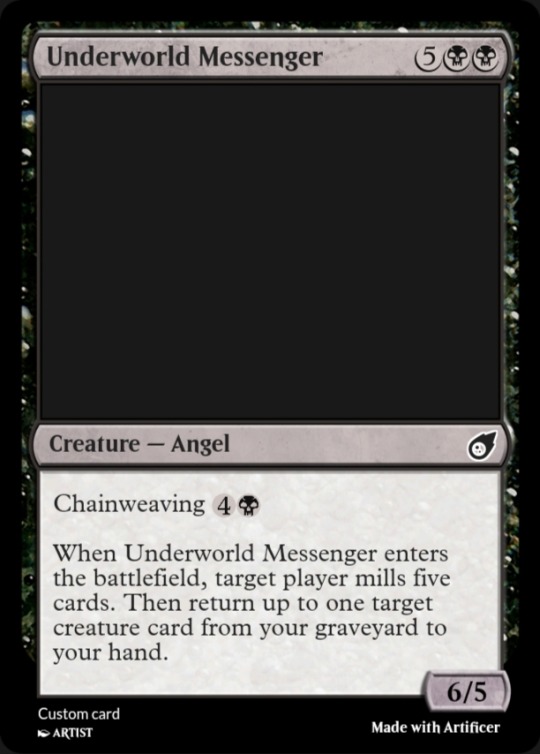
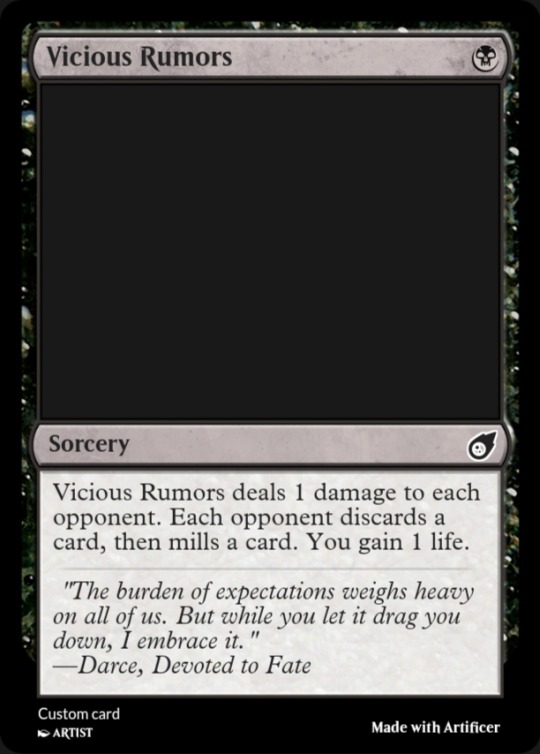
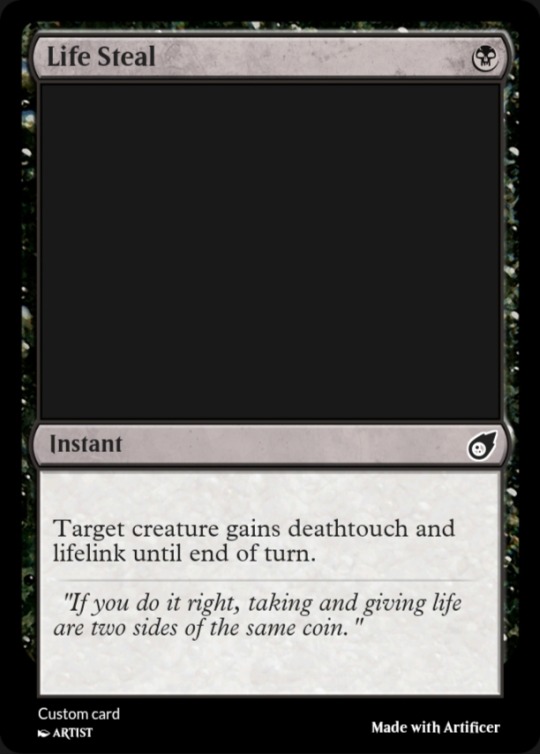



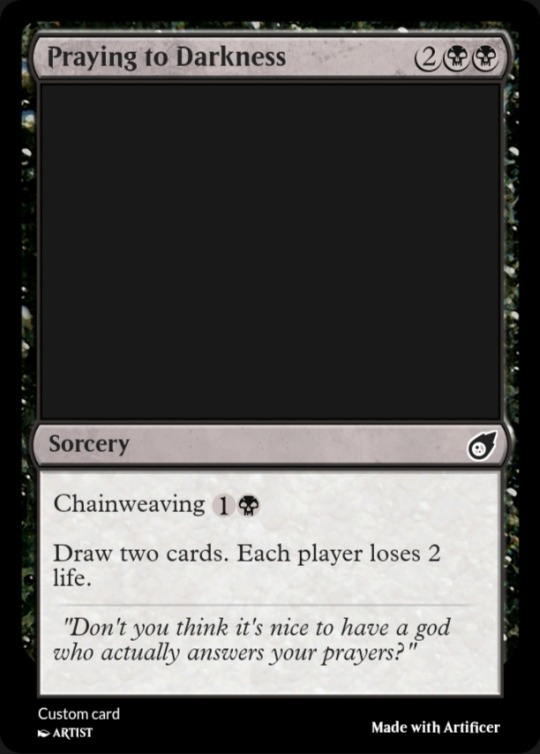
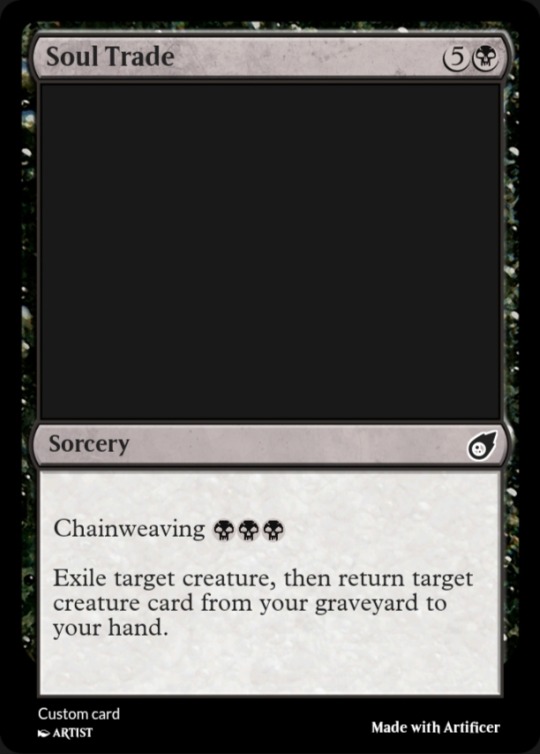
#I started attributing some of the flavor text quotes to actual characters#Also Sell Your Soul's second effect might be a bit weird#But it makes sense flavor wise trust me#It also lets you get back Darce after activating his ability#Talking of Darce#I feel like flavor wise I have to give him dedication#But his card already has way too much text on it#So I'd probably have to completely rework that card#Which is funny#Because the dedication mechanic was literally made with his design in mind#custom cards#Also a few more of these cards were gonna have chainweaving#But I took that away because chainweaving isn't supposed to be black's thing#Even four out of sixteen feels like a lot#It's only two less then white and blue#Which are the chainweaving colors#But chainweaving kinda make sense flavor wise#Honestly it would almost make more sense if I gave black more chainweaving and white more dedication#But only almost#Neither of these mechanics really have just one thing they can be flavor wise#So really it works regardless#Actually nevermind#Thinking about it again dedication definitely makes more sense in black#Whatever I'm just rambling lol#Probably not even making any sense#But it makes sense in my heart okay?#lmao my notes rambling really gets bigger with every bunch of cards I post lol#custom cards 1
0 notes
Text
Words About Games: Bloodborne (From Software, 2015)
I wanted to finally do one of these for Dark Souls 3, but realized that I'd finally have to do one for Bloodborne first. This is something I've put off for two years because I wasn't really ready to try to articulate my thoughts about it, but it's time to face these demons and cut them to ribbons in the process.
From Software's deeply, deeply flawed masterpiece of werewolf killing and beast chopping devoured weeks of my attention, and is to date the only game I felt driven enough to 100%. Which is strange, because after two and a half years, I still can't tell if I liked it or not. Let's try to sort through this mess.
I'll start by, as I did with Dark Souls 2, outlining my experience. I played through Bloodborne on three different characters, took one all the way through New Game+, and got the Platinum trophy for getting all the other trophies. I killed Ebreitas, I slogged my way through all the Chalice Dungeons, and I've gone through the game using each weapon for a respectable amount of time. But I never ended up buying the expansion, and I wasn't at all broken up when a random brownout during a loading screen deleted all my saves.
Bloodborne is a game that feels more like two halves of very good but separate games inexpertly mashed together to form a perfectly serviceable single game. It's enjoyable, don't get me wrong; I don't at all regret the time I put into it and have even entertained thoughts of starting over, it's just that I never follow through when I start to think ahead to the second half of the game.
See, Bloodborne starts off as and is sold to you the player as a Victorian-era werewolf/beastman hunting simulator. And for the first chunk of the game, it is. A very good one, too! Combat is speedy and interactive, enemies are grotesque things that were once familiar but now are not, and the environment of a crowded turn-of-the-century English city is a perfect sell.
The gist is that for currently irrelevant reasons, the city of Yarnham partakes in odd medical practices that involve consuming blood in some manner. Can't really say if it's by drinking it, injecting it, or by smearing it all over themselves. You do two of those things. The blood is great at curing diseases, but has the unfortunate side effect of slowly turning people into a whole manner of gross shit, and occasionally the city locks itself up to allow a force of Hunters to come in and clear out the worst of them. A perfectly reasonable setup.
So you go through some impeccably detailed environments, cutting down mutated townsfolk, wolfmen, weird birds, gross dogs, and big lumbering dudes who look like when Mr. Hyde wore a three-piece suit in The League of Extraordinary Gentlemen.
This is easily my favorite part of the game. The level and environment design is among From’s best, with the twists and turns of Central Yarnham sprawling through sewers and into residential areas, over bridges and across areas you'd been in half an hour ago and didn't realize there was more to. Capped off by a stroll through what I consider the best-realized “Spooky Forest” in a videogame that leads to a shortcut back to the starting area that made me relive taking the elevator down from the Parish church back to Firelink, the first big chunk of Bloodborne is expertly presented.
And then you get to Byrgenwerth. Byrgenwerth is the game's Creepy Oxford; hyped up as a massive university where terrible experiments of alchemy and black magic are carried out. It's supposed to be the place where this all started, where the old scholars got their ideas and unleashed this blood plague upon the city while trying to pursue immortality. At this point in the game and pretty much until the end, the game tells you that there is no place more important than Byrgenwerth.
So it's a real shame when you get there and it turns out to be a single room.
Byrgenwerth marks the end of the grounded concept the game started with, as well as the end of my fascination with it. Byrgenwerth marks a massive shift in how the game is presented, how the narrative unfolds, what your purpose is, and why you've come to Yarnham.
Byrgenwerth is where you start fighting aliens.
To be fair, you can do that a tiny bit earlier in the Spooky Forest, down a hidden side path. But once you beat the boss at Byrgenwerth, you get a cutscene that basically tells you “Yes hello now it is time for weird shit” and then you get teleported to a new part of the city. And there are aliens. From this point on, the game ditches the werewolf-hunter angle entirely and makes it all about tracking down this weird baby who’s part alien god or something; Vaati can tell you more about the story if you really care.
Design-wise, it all starts to wobble a bit. Levels become smaller, bosses become less mechanically interesting, and everything starts leaning super heavily on Lovecraft. Weird aliens, possible space-gods, literal body snatchers; it’s all so jarringly different from the first half of the game, and not in a thematically interesting way. It’s just incredibly different.
Okay, so the first part of the game is, again, essentially a massive single level that spirals and crawls all over itself in a way that is extremely satisfying to go through. After Byrgenwerth, you’re shuffled through smaller and smaller levels that are barely connected until you just kind of find yourself at the end of the game. There’s a place called the Lecture Hall that’s supposedly connected to Byrgenwerth, but it’s not anywhere near there, and the two exits on either side of it lead to entirely disconnected areas in The Nightmare Frontier, a place made entirely of bleeding tombstones and poison water, and Nightmare of Mensis, an area that while technically better put together than Lost Izalith, elicits many of the same reactions.
The Lecture Hall is two floors of simple, boxy rooms. Nightmare Frontier is an uninteresting, flat expanse filled with enemies throwing instant-kill projectiles at you. Nightmare of Mensis is a big creepy castle guarded by some of the most annoying enemies in the game and populated with the others. Neither are actually horrible, but the lack of connection to anywhere else is just disappointing. Add in secret bonus areas that are supposed to have a pretty big amount of plot significance like The Orphanage (a single room) or Cainhurst (a big impressive castle that you barely actually go through) and it all just left a bad taste in my mouth the longer I thought about it.
I said at the beginning that the game felt like two halves of other games inexpertly stitched together. What I mean by that is that the story of that first game didn't seem done being told. There was still a lot of mileage I felt that could have been gotten out of the setting, and instead of giving it a satisfying conclusion that rolled naturally into the second half, it was rather unceremoniously cut short to make room for this new thing that suddenly came into existence. And the problem then with that new thing is that it didn't seem to have nearly as much care and attention put into as did the thing that had just been yanked offstage Vaudeville style, complete with comically oversized shepherd's crook.
My personal preference, then, is that the entire game would have been about this creepy blood plague people get from drinking weird fluids they found in an ancient catacomb. It could have even gone the alien angle later, maybe saving that for the last third or even the last quarter of the game rather than an entire half. There just seemed to be so little to go around in the latter half, while the first part still seemed brimming with ideas. Instead of having us get transported to a secret sealed-off part of the city, have us go down into those catacombs and find what started this whole thing; make the last bit of the game one frantic rush to just barely touch the surface of what's really going on in Yarnham.
But oh wait, they tried that.
Yes, enter the Chalice Dungeons, a system for making procedurally-generated maps and mazes to fight through! Only the finest square hallways and maddeningly repetitive rooms here, filled full of enemies that didn't make the cut for the main game! Grind for hours to gather materials to make a new map, all for a chance to find a marginally better Diablo 2-style insertable weapon gem! Chase that +1.3% increased critical damage, good Hunter!
In a word, Chalice Dungeons are shit. But they're ignorable shit, there solely for those who find joy in them and the treasure hunting they allow. Or they would be, if the true final boss of the game wasn't locked in there four-deep.
Throughout the game, you're occasionally given new chalices from boss encounters. They don't do anything on their own, and are there only to participate in this system. But you can't just put them on their little altars and hop over to the maps they control, no no no. You need crafting materials to make the maps, even the ones that aren't procedurally-generated that make up the four story-relevant ones. You get . . . most of them along the normal course of the game, either through drops from specific bosses or as out-of-the-way item pickups. Others drop from enemies, so draw your own conclusions there.
The story-relevant dungeons are at least hand-crafted, but it doesn’t do a lot to get rid of the issues. There’s no real theme beyond “blocky dungeon,” even when mildly-different tilesets add environmental decals and different decorations. You have a short hallway, a long hallway, an L-shaped hallway, three or four flavors of rooms with enemies in the same places each time, two different trap rooms, and two different big setpiece rooms. To their credit, they do (sometimes) populate the dungeons with unique enemies and bosses, but as I said above, a lot of the stuff you can only find in Chalice Dungeons feel like leftovers from scrapped main-game content.
I don’t know what the Chalice Dungeons were supposed to be. Maybe they were supposed to be a side project that got rolled into Bloodborne when the deadline started to loom, maybe they were supposed to be way more involved and part of a more complex post-game, or maybe they were just supposed to be a neat distraction for people who wanted more. But the problem with that last one is that you are forced to go through four of these things to get the true final boss, and they are anything but short. Each dungeon is pretty sizeable, certainly larger that some lategame areas in the main game, and the challenge they pose is on par with the rest (unless we’re talking about Cursed Pthumerian, holy shit that was painful). I could understand having to go through one heavily-curated dungeon as a way for From to say “hey, come check these out!” But that there are four of them that make a hefty demand on your time and resources, I just don’t know. To make it even worse, enemies in Chalice Dungeons only drop materials for crafting new dungeons. No dungeon-specific weapons or armor in the four of them to reward you, only dungeon crafting materials and those randomized weapon gems for nigh-inconsequential bonuses. There’s just no tangible bonus for doing these things past what it takes to fight the end boss.
And speaking of resources, let’s dive into that. The game does away with Dark Souls’ Estus Flask - the rechargeable, always-available but limited healing option. Instead, we’re taken back to Demon’s Souls-style consumable healing items, with a couple caveats. There’s only one type, you can only carry 20 at a time, they increase in price from vendors as the game goes on, and later-game enemies, for the most part, simply do not drop them.
I realize I’ve not actually spent much time on the game’s mechanics, so let me jump back a second to talk about the Regain system. Combat in Bloodborne was, at the time, much faster than anything in any of the Souls games. Rather than focusing on slower, more cautious and methodical combat, Bloodborne fully expects you to trade hits with the enemies. Combat is rapid; your roll is replaced by quick-stepping in any given direction, leading to dodges that cover less distance but that treat avoiding damage as secondary to repositioning. Even the largest weapons swing quickly, and most hits stagger enemies just enough that the game wants you to dance around groups of them, using a series of unrelenting attacks to manage the crowd rather than waiting behind a shield for your opening. So when you do inevitably get hit, the game doesn’t want you retreating, it wants you to jump right back in there and earn your health back. For a short but generous-enough time after taking damage, hitting the enemy will heal you for up to the amount you were at before, and it’s absolutely possible to fully negate the effects of a swipe to the gut.
So with that in mind, having 20 Blood Vials that instantly-regenerate 40% of your total HP seems reasonable, and it is for much of the game. Coincidentally, the first half of the game. Early on, you often face groups of 5 or so enemies at once, or individual ones that are slower. There, the system works great. Do a bit of damage, trade a few hits, dash back and use a single Blood Vial to give yourself a safety net, hop back in to finish everyone off. Get a couple vials back off the enemies as a prize. Later though, you’re facing down enemies mostly by themselves or with only one other, and they hit much harder while still being fast. It becomes a lot riskier to try to get the full heal off the Regain system, so maybe you want to dash out and pop a vial. As you go on through the later levels, it can be a pretty common occurrence to see your Blood Vial counter dwindling; not out of any real fault of your own for not playing well enough, but just because the game, again, expects you to trade hits, and has now changed how your damage matches up versus your enemy’s.
You can store up to 600 extra vials in your storage box at home base, and your personal stock of 20 is replenished from that total when you respawn or go to a different area, so it’s not like you have to rush back to buy 20 more every time you use them up. But you do definitely find yourself running out faster at the end of the game than you were previously. You can only Regain the effects of the most recent hit you take, and nothing past it. So if an enemy has, say, an uninterruptable frenzy attack that does multiple hits you can’t escape from for a small amount of damage each hit, well . . . Blood Vials are the only way to regenerate health you’ve fully lost. In Dark Souls, topping yourself up before a tough enemy encounter was a reasonable thing, because you’d get that estus back at the next bonfire. In Demon’s Souls, chowing down on some Half-Moon Grass beforehand was fine, you were carrying 80 of the damn things, plus dozens of the other types. Dark Souls 2 gave you Lifegems to make up for a smaller stock of estus, and even the King’s Field games had refillable health potions mixed with findable and buyable Earth Herbs. Plus, each of those games had healing magic. Bloodborne has “fight for the health you just lost” or “heal 40% of your HP, 20 times.” Yes, as I said before, you can in fact buy more vials, but the increasing price combined with the carry limit make it difficult to rely on getting them that way.
The game treats bullets much the same way. Oh, right, you have a gun in Bloodborne. You use to parry enemies, don’t worry about it. Like Blood Vials, you can carry 20 on you at a time. But you don’t just use them to shoot stuff, you also use them as ammunition for certain special attacks, or to cast spells. So I’ll just come right out and say it, doing “a mage build” in Bloodborne is pretty much a waste of everyone’s time. You don’t get useful spells until halfway through the game, and you cannot reasonably hope to defeat enemies with magic because you simply don’t carry enough bullets to make it happen.
So, bullets. Enemies at least drop them a little more generously than they do vials, and there’s a nifty little thing From put in the game to help you out. At any time, you can press a button to sacrifice 30% of your health for 5 extra bullets. It’s a neat system, it plays nicely with Regain, and it helps you conserve resources. No complaints there.
Alright, I’ll be honest here. I’d taken a step away from this massive wall of text for a few weeks, and I think it’s best to just close the book on the whole thing. If I haven’t been able to show you that my thought on Bloodborne are super conflicted by now, it won’t happen even if I write another five pages.
Bloodborne is a great game. Combat is fast and responsive, the graphics are superb, the aesthetic is wonderfully realized, the level design starts off so strong, and the difficulty feels natural. But Bloodborne is also a mess. Some systems feel half-baked, the superb graphics combined with too much post-processing leads to slowdown fairly easily, the level design turns to garbage in the lategame, Chalice Dungeons were a mistake, and the game clearly has no idea what it wants to do with itself. For the third time, it feels like two different, unfinished ideas were mushed together to make a technically finished product, but it just ends up feeling like you’re awkwardly stepping from one to the other.
What I’ve felt about Bloodborne from the first time I finished it is that From had a lot of ideas, but spent far, far too long fleshing them out before actually considering how they would function as a game. They allegedly started working on it while Dark Souls 1’s Artorias of the Abyss expansion was being made, which gives them around three years to have put the entire thing together. Quite long for a modern game, but considering that so much changed from the Project Beast trailer that came out 7 months prior to Bloodborne’s release, I just don’t know.
So much stuff feels like it was cobbled together at the last minute. It feels genuinely unfinished on a conceptual level. The actual mechanical gameplay doesn’t suffer for it, but something definitely feels missing from every other part of the game. Maybe we’ll see it again some day, like March of 2016, or April if you don’t live in Japan. And then two weeks later on PC for no reason.
2 notes
·
View notes
Text
Modern Horizons 2 Booster Challenge
Hello everyone, and welcome to the Modern Horizons 2 Booster Challenge! For the past few sets, a bit after release, I’ve been replicating this challenge from GDS3, in which contestants created a draft booster’s worth of cards that could feasibly be in their chosen set. I made a lot of designs for this one (I have 60 different cards made, and those are just the ones that are completely finished with art and everything), so choosing the best for this pack was quite hard. Some of them are definitely pushing the power level a bit, given the nature of the set, but I think that’s okay at least for designs like this. Now let’s jump into it!
Link to the full booster
Common #1
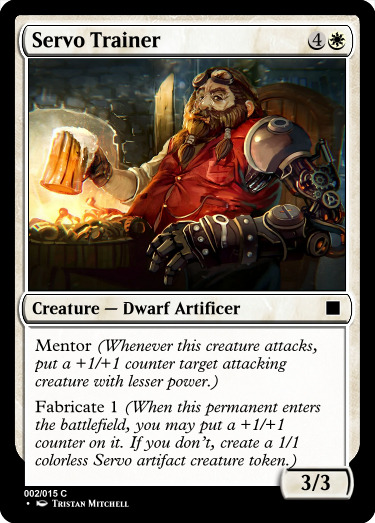
Servo Trainer 4W
Creature- Dwarf Artificer
Mentor
Fabricate 1
3/3
Modern Horizons sets are great, cause you get smash two mechanics together and see what happens. I was really surprised we didn’t get a fabricate card in the set, since it works well with several set themes, so I decided to make one and then looked to see what interesting things I could do with the mechanic. I scrounged fabricate + mentor from an old design of mine cause I really like the combo- it works well on multiple levels.
Common #2

Crusader’s Arrogance 2W
Enchantment- Aura
Enchant creature
Whenever a creature enters the battlefield under your control, put a +1/+1 counter on enchanted creature.
I wanted to make sure I had some designs that didn’t use keywords, and callback designs like this make for good candidates. This is a reference to [[Cathar’s Crusade]]
Common #3
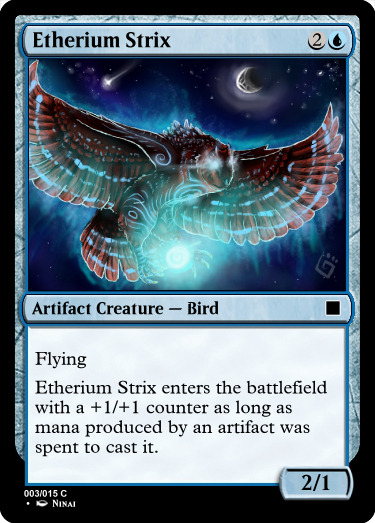
Etherium Strix 2U
Artifact Creature- Bird
Flying
~ enters the battlefield with a +1/+1 counter as long as mana produced by an artifact was spent to cast it.
2/1
I’ve long been interested in cards that care about artifact mana, and Modern Horizons 2, with ten common artifact lands and a bunch of treasure running around seems like a great candidate.
Common #4

Unethical Experiments B
Sorcery
Return target creature card from your graveyard to your hand.
Jump-start
With the various discard and graveyard themes of the set, jump-start seems like a great candidate to use. I wanted to put it in a color that didn’t already get it, and black seemed like the best candidate given draft themes. Creature recursion seemed like a good ability since neither red nor blue could have a card like this. My thought process went jump-start plus recursion, hmm sounds like frankenstein. So i made the card stitcher-themed.
Common #5

Reckless Search R
Instant
Draw a card.
Madness R
This is a colorshifted version of [[Obsessive Search]]. It’s a tiny bit weird, colorpie wise, but not by much. Every color gets cantrips, and while usually cards that are just cantrips tend to be blue, red gets discard then draw, so I think a madness cantrip like this makes a lot of sense in the color. And since blue doesn’t have access to madness in this set, only red black, I think this works well.
Common #6
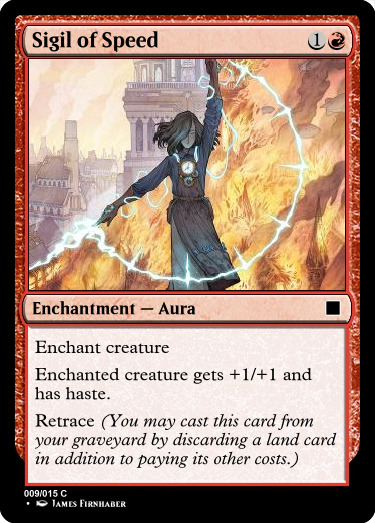
Sigil of Speed 1R
Enchantment- Aura
Enchant creature
Enchanted creature gets +1/+1 and has haste.
Retrace
I had this spell as one mana for a bit, and I still think it could though it would definitely be kinda strong. I mainly just changed it cause there were already a decent amount of 1 drops in this booster, including the other red common. I really like putting retrace on permanents though, and Auras especially make for good candidates.
Common #7
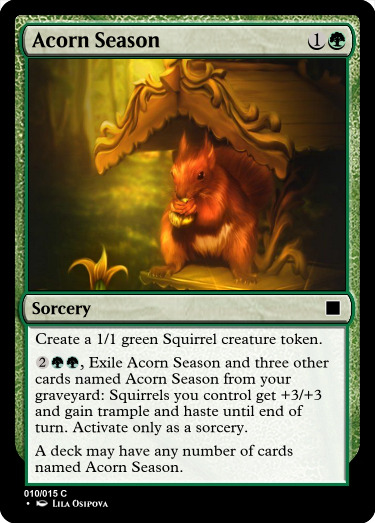
Acorn Season 1G
Sorcery
Create a 1/1 green Squirrel creature token.
2GG, Exile ~ and three other cards named ~ from your graveyard: Squirrels you control get +3/+3 and gain trample and haste until end of turn.
A deck may have any number of cards named ~.
I really liked the idea of a [[Relentless Rats]] style card for squirrels. So I made one. I played around with the numbers on this a lot, and I’m still not 100% sure if it’s at a good level. I know I wanted the card to cost two though, since at one mana you can fill your graveyard with these way too quickly. And since the card itself is pretty bad on cast, the big payoff could be stronger since it means you’re filling your deck with otherwise bad cards.
Common #8

Relentless Wolf 3G
Creature- Wolf
Undying
Creatures you control with +1/+1 counters on them have trample.
2/2
I’ve played around with undying + counter synergy before, and liked the results so since this set has a +1/+1 counter theme this seemed like a really good place. The second ability is often used with these themes, in fact there was even one in this set, and I like how it plays on undying so I put one here- probably as a replacement for the one already in the set, since it doesn’t need two at common.
Common #9
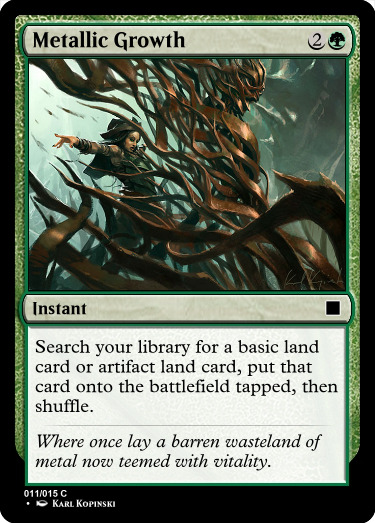
Metallic Growth 2G
Instant
Search your library for a basic land card or artifact land card and put it onto the battlefield tapped, then shuffle.
Since the set has artifact land cards, I enjoy tacking them onto where we usually see “basic land”. This started out as a [[Lay of the Land]] but I think I prefer it as a ramp spell.
Common #10
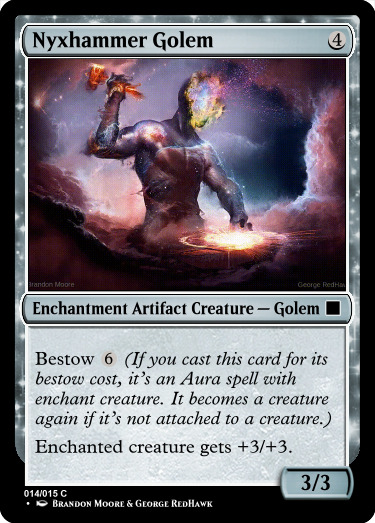
Nyxhammer Golem 4
Enchantment Artifact Creature- Golem
Bestow 6
Enchanted creature gets +3/+3.
3/3
I wanted an enchantment artifact creature for the delirium archetype, cause a three type card does a lot for that. So I needed to justify why it was both of those types, and I think being a colorless card with bestow is a good way to do both.
Uncommon #1
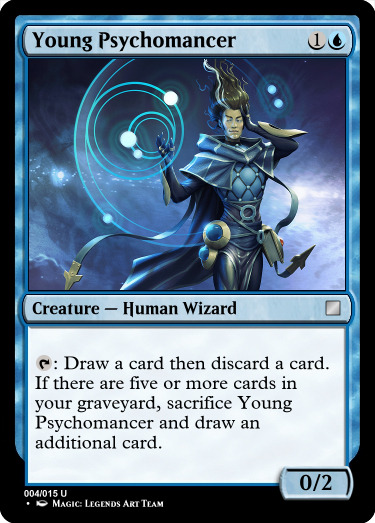
Young Psychomancer 1U
Creature- Human Wizard
T: Draw a card then discard a card. If there are five or more cards in your graveyard, sacrifice ~ and draw an additional card.
0/2
I originally named this card Jace’s Prodigy as a reference to [[Jace, Vryn’s Prodigy]] that I copied used as inspiration, but I preferred the flavor of an imitator than a student of Jace since he isn’t really a teacher which made made Young ____ a good candidate. This is definitely a bit of a strong card though, quite possibly too much. It might be better to go for a different payoff than draw a card, but I liked the simplicity.
Uncommon #2
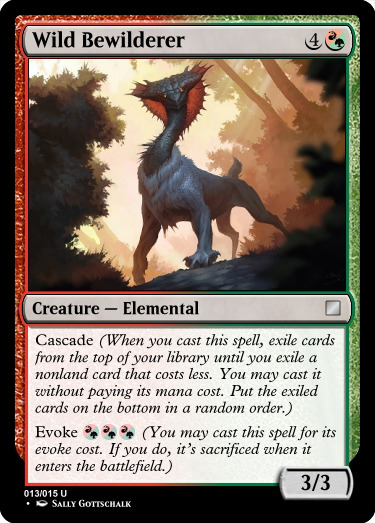
Wild Bewilderer 4R/G
Creature- Elemental
Cascade
Evoke R/G R/G R/G
3/3
This is a card intended to help the RG storm archetype, since it lets you cast two spells for cheap. It also just is a very fun combination of keywords that I’m surprised hasn’t ever been done.
Uncommon #3
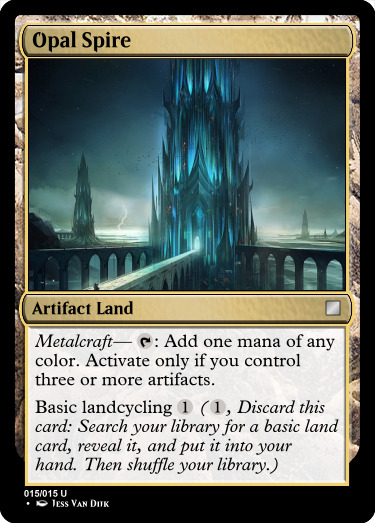
Opal Spire
Artifact Land
Metalcraft- T: Add one mana of any color. Activate only if you control three or more artifacts.
Basic landcycling 1
Here’s one of the cards that’s really pushing it power-level wise. Is this wildly broken? Quite possibly. This is by far one of the cards I'm most worried about. Artifact lands are scary, particularly those that enter untapped. This card is, of course, a reference to [[Mox Opal]], but that’s an ability that’s much less scary on an artifact land than it is on a 0 mana normal artifact, so there’s a little room for something extra, I feel, and still be well within a safe power level. And since they generally don’t like to make lands that don’t unconditionally make some kind of mana (they sometimes do, but not often) that seemed like a good place for the extra. I tried “T: Add C” but that seemed like a bit much for artifact decks, so then I moved to basic land cycling which means you can still use it to get an unconditional mana land but the unconditional mana doesn’t get those same artifact synergies. This also adds discard and graveyard synergy, which works well in this set- I could see the UR delirium deck playing this and never intending to have it on the battlefield. The end result, though, is still something I’m incredibly scared of but I think it’s a cool design. So I’m choosing to stick with it, cause since these cards aren’t really gonna get played anywhere I generally tend toward the more exciting numbers.
“Reprint” Slot
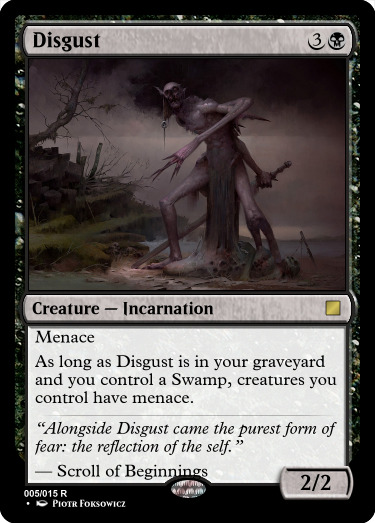
Disgust 3B
Creature- Incarnation [r]
Menace
As long as ~ is in your graveyard and you control a Swamp, creatures you control have menace.
2/2
I ran into a similar problem with “reprint slots” with strixhaven’s mystical archive cards, but there I solved the problem by making a card that couldn’t be in Strixhaven by using the mechanic retrace. That approach doesn’t really work here. Separately from this problem, I realized that while the rest of the incarnation cycle fits well with modern design, [[Filth]] doesn’t as much since swampwalk isn’t really used much anymore, so I decided to make a version that used menace. Then I realized that would be a good candidate for a “reprint” here, so I stuck it in.
Rare
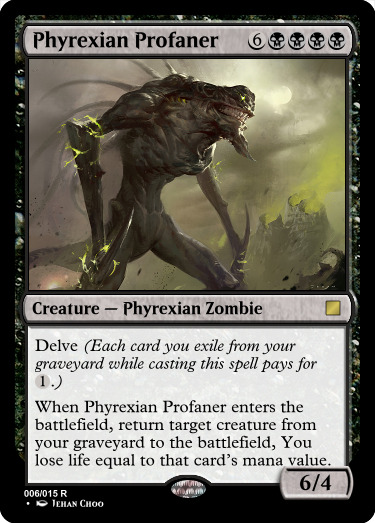
Phyrexian Profaner 6BBBB
Creature- Phyrexian Zombie
Delve
When ~ enters the battlefield, return target creature card from your graveyard to the battlefield. You lose life equal to that card’s mana value.
6/4
Here’s another card that’s pushing it, power levelwise. (As I said in the into, that’s a theme in this booster. That’s what happens when I try to make cool cards for modern being the most casual player out there.) MH2 had a joke where they took cards with “eternal” in the name, and gave them the eternalize mechanic. This is a similar reference to [[Phyrexian Delver]], but with delve. It definitely feels strong, and I’m sure it is, but I rationalized it like this- 4 mana reanimation is not gonna make a splash in modern, let alone reanimation with a downside and strict color requirements. So the draw here is that it also comes with a body, which leads to the question of just how pushed does that body need to be to make the card attractive? I decided to stick with the most melviny numbers, where the mana cost and the stats are both double that of delver. But as I’ve said, balancing is not my strong suit.
So there it is! How would you feel opening these cards from a pack? Are any of them wildly broken and going to ruin multiple formats? Let me know in the comments!!!
4 notes
·
View notes
Text
So, what emotion(s) does the Mandarin need to use for his power rings?
You might think by the opening panel to this comic that Iron Man is shrunken by a caricatured* evil Chinese man in this issue.
You’d be wrong.

Some Pentagon generals ask Iron Man (not Tony) to go to “Red China” (It’s always called “Red China”...We get it, Stan, they’re communists...) and gather intel on some character called the Mandarin, who is rumored to be the “greatest single power in that nation”. Iron Man literally drops into the country, takes out some (questionably drawn) guards, and accidentally gets caught by, of all things Iron Man could possibly get caught by, a giant magnet.

[This magnet ray gun thing is powered by one of the Mandarin’s ten power rings, which are very different from what I normally think of when I hear the phrase “power ring”. In this issue, we’re shown four of his ten powers: he can make things vanish (including himself), levitate giant rocks, cause paralysis, emit loud sound waves, and...power a giant magnet. These are obviously expanded upon in later issues, but as of now, we have no idea what the rings are made of, how they work, or what the others do.]
Re: Tony’s speech bubble, there actually are multiple forms of magnetic attraction, though whether or not Stan and Co. knew that is up for debate.
On an atomic level, you have electrons buzzing around nuclei. Sometimes those electrons are involved in bonds, sometimes they’ve been donated into a communal sea and can easily move from one atom to another (This is what makes metals conductive), and sometimes they’re just doin’ their own thing. But they’re all negatively charged, and do you know what happens when charge moves?
You get a magnetic field. This is a consequence of relativity, and we don’t have time to get into it, now. But the important thing to walk away with is that each electron acts like a teeny tiny magnet.
Normally the electrons buzzing around are doing so in completely random directions, so if you have a lump of substance, the teeny tiny magnetic fields are pointing in all directions and cancel each other out, so there’s no net magnetic field.
Compounds we call non-magnetic actually come in two flavors: diamagnetic and paramagnetic. The effects (”diamagnetism” and “paramagnetism”) only show up when our lump is placed inside an external magnetic field which is why we think of them as non-magnetic.
Diamagnetic materials are repulsed by an external magnetic field - their electrons all reorient themselves so their magnetic fields are pointing the opposite direction. Paramagnetic materials are attracted to the source emitting the field - some of their electrons*** express diamagnetism, but some align in the same direction of the field and express paramagnetism, which is a stronger effect.
[Science demo note: If you cool oxygen gas enough to turn it into a liquid, you can pour it between two magnets and observe paramagnetic attraction in action:]

Ferromagnetism is what we traditionally think of as plain ‘ol magnetism. Unlike paramagnetic materials, they get to take advantage of an additional quirk of quantum mechanics. A group of atoms anywhere from .1 mm to a few mm***** in size will basically walk in lockstep acting as one ‘domain’ with its own (more intense) magnet; many domains make a lump of ferromagnetic material. When domains are randomly oriented, the lump of iron or cobalt or whatever isn’t magnetized. But an external magnetic field will cause each of the domains to point in one direction, parallel to that external field. That’ll produce a much stronger magnet than you would get from paramagnetism.
Ferromagnetic materials are capable of maintaining a permanent magnet field on their own, though high enough temperatures (material-dependent) or whacking it with a hammer (RIP MCU!Mjolnir) will cause many of the domains to randomize their orientations, effectively causing the lump to no longer be magnetic.
But while they’re a magnet, you have your standard “opposite poles attract, same poles repel” effect kids learn about in school or from decades old episodes of Bill Nye the Science Guy. Meanwhile, a paramagnetic substance can’t retain any latent magnetism, so it will always be attracted to another magnet, no matter which pole is pointing at it (Likewise, a diamagnetic substance will always be repelled no matter which pole is pointing at it).
Gold is diamagnetic, so the yellow bits of Tony’s suit are (assuming they are gold) weakly repelled by the Mandarin’s device. But this panel does at least tell us the rest of his suit isn’t diamagnetic. Or maybe it is, and the Mandarin violates the laws of physics more than his magic rings already allow him to do.
As for how the Mandarin’s machine may or may not work, magnetic fields don’t have to be made using lumps of matter. We can construct “temporary” magnets that use electric currents. Because all you need is flowing charge, you can take a wire, coil it up so it looks like a spring, and let a current flow through it. You’ll get a magnetic field that resembles the field produced by your traditional iron bar magnet.`* That being said, it’ll be stronger if you have a rod of iron (e.g.) in the middle.

You can also use flat metal plates in lieu of wire, stacking them so they make a helical shape (A hole in the middle is where the magnetic field gets concentrated, and the plates are all stamped with smaller holes all over so they can run coolant through the system).
Other examples of these “electromagnets”? The system that makes maglev trains a thing. The system that allows recording on magnetic tape and computer hard drives. Those magnets that pick up cars in junk yards. Those magnets that make your fake perpetual motion desk toy spin around. I mean, they’re everywhere these days with all the technology we surround ourselves with. Ever wondered how an electric doorbell works? Boom. Electromagnet.
All these are examples of “resistive magnets”. The other type of electromagnet is the “superconductive magnet”, which requires cooling by liquid helium to bring the material the electricity is flowing through to such a low temperature it loses all electrical resistivity. Essentially, the electrons don’t experience any friction as they move, so they don’t lose any energy. That makes superconductor magnets cheaper to operate electricity bill-wise, but you’re paying out the nose for the helium...which the planet is running out of...

The current record for the world’s strongest electromagnet (that can run continuously, as opposed to a fraction of a second) is the 45 Tesla Hybrid Magnet at The National High Magnetic Field Laboratory in Florida, a diagram of which you can see above.`** It combines a 11.5-T superconducting magnet with a 33.5-T resistive magnet to get that 45, which is about 30 times stronger than the strongest permanent magnets. It costs $1,452 an hour to operate and takes 6 weeks to ‘warm up’ (during which time it’s actually cooling down).
All this fun science info aside, I do wonder why Stan didn’t just make the Mandarin’s ring powerful enough to generate a magnetic field that could pull Iron Man in on its own.
The magnet ray deposits Iron Man in a granite-walled chamber, whose walls pull a The Pit and the Pendulum - not the heating up part, just the closing in part. Tony claims he can’t make a dent in the rock, apparently having gotten rid of his “diamond drills that can penetrate the toughest rock” from that time he fought a never-dead mummy in ancient Egypt in this new version of his suit (That was a poor decision, Tony). But he just flies out an air vent and fights the baddie for a bit.
Tony tries knocking him out with some sort of high-frequency music (at least it should be music, given the eighth notes in the panel), but the Mandarin cancels that wave out with one of his own.

I’m going to ignore the question of how “high” their frequencies actually are, as well as Tony’s claim that nothing can escape his blast (Sound, you may recall, doesn’t propagate in a vacuum, so there’s a whole class of exceptions, there) and instead focus on the Mandarin’s claim that two high frequency waves nullify each other. That is true...under one specific condition. They have to be the same frequency, and the same amplitude, and one has to be perfectly out of phase with the other (You can play around with different settings here).
If the waves are identical, they’ll just add together, which is something neither of the men want.

This ‘nullification’ is how noise canceling headphones work, i.e. it works for any sound wave, not just high frequency ones.
This is also how wave interference works in general.
Iron Man loses battle #1, and the Mandarin decides the best way to finish the job is use his karate skills. Because he not only has a bunch of power rings, he’s also the “greatest karate master the world has ever known”.

[Fun fact: while Karate is thought of as a Japanese martial art, it actually comes from the Ryukyu islands, which Japan annexed in the late 19th century. The martial art itself was developed under a lot of Chinese influence, but it’s obviously evolved since then, and there are a bunch of different types. So it’s not necessarily the writer conflating all East Asian martial arts...]
Iron Man beats him with a "built-in slide-rule calculator” (which I find absolutely hilarious) and geometry.

If you want a quick fact check on that “at an angle of 38 degrees, the velocity decreases by 52%” claim, well, we don’t really know what Tony’s talking about. Does he mean the Mandarin’s strike will somehow travel more slowly if Tony raises his arm just a bit higher? Unlikely, as the angle is clearly the important part.`*** I want to imagine Tony really means a glancing blow would be less injurious, which is true. Force depends on a change in velocity, not the velocity itself, so a blow where the Mandarin’s fist doesn’t slow to zero would mean less force gets applied to Tony.`**** That’s more likely to happen if he angles his arm.
Let’s pretend for a moment the Mandarin’s strike wasn’t completely halted, as the bottom middle panel suggests. Say the Mandarin’s hand strikes Tony’s arm (which has been tilted by 38 degrees), and keeps going along it. The Mandarin’s velocity vector would change direction by ~52 degrees (Is that where Stan got the 52 number? 90 minus 38? No Stan, no. That’s not how vectors work...).
Like so:

Unfortunately, just knowing that angle doesn’t tell us how much the Mandarin’s fist will slow down by. It depends on the kind of collision that happens - how much energy is lost. If it’s an elastic collision and no kinetic energy were lost (which clearly is not the case), we could get the change in impact force just from the angle. It’d be about 88% the original (i.e. reduced by 12%). If you wanted a 52% reduction, the angle of deflection would need to be ~24.25 degrees, meaning Tony would have to rotate 66 degrees, not 38.
But again, that 38 could reference a completely different angle, just one part of a many-step calculation Tony has to do with his head and a slide-rule. Because our weapons manufacturer hasn’t figured out how to shrink a computer down to fit into his suit, yet.
The comic ends on the next page, with Tony catching a plane out of China and showing up late to a party for his employees he’d previously said he wouldn’t be able to make.
That makes him a slightly better superhero alter ego than those that promise they’ll do something and don’t (*cough* Peter *cough*).

* It’s the 60s, so seeing some pretty racist depictions of non-Western ethnic groups is unfortunately unsurprising. Stereotypical negative depictions of the Other** continue to this day, though the ones that propagate mainstream media aren’t usually so...obvious? Is that the right word?
I don’t know how more modern portrayals of the Mandarin (outside of Iron Man 3, which I will acknowledge as...existing) go, but I assume they’ve toned it down.
** No, not the Others from ASOIAF -- people who aren’t like you, be it because of different culture, ethnicity, religion, gender, orientation, etc.
*** Specifically, the ones that are paired. When you’re dropping electrons into their orbits around an atom’s nucleus, depending on the total number, some of them will pair up (with one having an ‘up’ spin and one having a ‘down’ spin****). Some of them won’t. When two atoms bond with one another, unpaired electrons might end up paired (e.g. water), and they might not (e.g. oxygen gas).
**** They’re not actually spinning; it’s an analogy.
***** That’s really big when you consider how tiny atoms are...
`* Usually the coil of wire is wrapped around a ferromagnetic material to amplify the result.
`** Despite its size, the bore hole (i.e. the hole you actually put samples in for study) is a whopping 32 mm.
`*** He does say in a later panel “...insuring that his [the Mandarin’s] hand would strike [him] at the wrong angle”.
`**** If an object bounces at too high a angle, >60 degrees, it’ll actually impart more force.
This might be a record for footnotes...
Enjoy the blog and have a dollar to spare? I have a Patreon, now.
Tales of Suspense #50 - Writer: Stan Lee, Art: Don Heck
Image Credits:
Paramagnetic oxygen from https://www.youtube.com/watch?v=Lt4P6ctf06Q
Magnetic field lines By P.Sumanth Naik, CC BY-SA 3.0
https://nationalmaglab.org/user-facilities/dc-field/instruments-dcfield/resistive-magnets/45-tesla-2
0 notes
Text
Life is Strange reviewed two years after it came out because I just played it and I wanted to review it
(Spoiler-Free)
Life is Strange, an episodic adventure game from the same guys that made that Remember Me game that no one played, originally came out in 2015. I was aware of it but wasn’t playing it at the time so I didn’t engage in any of the discussion around it, but I recall that it ended up being quite popular and spawned a pretty big fandom. While I think I do miss a lot of the initial appeal of being able to discuss it with a large group of people as it was coming out, getting around to playing it now is still something I’m glad I did. The game’s definitely an experience, even if it’s not a perfect or even always a particularly happy one.
You control Max, a disaffected hipster girl taking a photography class at an artsy Oregon high school who stumbles her way into a wide-reaching web of teenage angst that ends up evolving into a murder mystery. She’s urged into action by reuniting with her childhood friend Chloe after an intense encounter where Max discovers she has the ability to rewind time. This ability forms the crux of the adventure gameplay, and it’s impressive how much the game leans into it and lets you use it. You can rewind at virtually any point, moving characters and objects back into positions they were previously, talking with people to get information out of them then doing the conversations over with new knowledge, and generally solving puzzles in creative, fourth-dimensional ways. You also use your power with the game’s other big mechanic: choices. At several points in the game you’ll be tasked with making divergent decisions. You make your choice, and are able to see the immediate consequences of your actions play out, so you can rewind, try again to see what happens with a different decision, and use all that info to decide which choice you want to stick with.
The time-travel mechanic fares pretty well as a game gimmick. It’s interesting to have a game where the use of continues is an in-universe convention. Failing at major tasks just prompts you to rewind and try again, so even though you are effectively restarting a ‘failed level’ each time, it doesn’t feel quite so monotonous as in other games, and helps it keep the feeling of being a continuous, unbroken sequence. Being able to rewind time generally also lets you take all the time you want to figure out puzzles, even ones that would normally be time-sensitive, like figuring out how to rescue someone caught on railroad tracks with a train closing in on them. It also means you can repeatedly attempt many minor side-challenges, like warning someone to look out for a football, as many times as you like without having to restart a section over every time.
One of the big selling points of Life is Strange is ‘All your decisions will have permanent consequences’, and this is technically true, in as far as say, choosing to write some graffiti on a wall will have the consequence of that graffiti being on the wall the next time you see it. In practice, the way this works is things you do and say to characters will come up with them again when you interact with them later, which can change the way encounters play out and even how you have to go about some things gameplay-wise. A lot of it is just flavor, changing what angry text messages you get from characters and the like, though there are a few big decisions that will have major ramifications on how the rest of the story plays out, and you’ll experience these as early as Episode 2. There are times when the game feels like it’s showing off, characters talking to Max and bringing up multiple things she did in rapid succession, then telling you that those specifically are why other things are happening. Other than that though, the game’s story still follows the same path and basic beats regardless of which choices you make. This issue comes to a head in the final chapter and especially the ending, but more on that later.
In spite of being less divergent than you’d think for a game about making choices and rewriting time, the story it’s all in service of is a good one. It expectedly features numerous twists, and while some are easy to see coming if you’re experienced with this kind of fiction, others still managed to shock me pretty well. It has a well-paced build to it, with Episodes 1-3 introducing all the characters and conflicts and immersing you in the world, before the fourth episode (which is almost as long as the three before it combined) ushers in a ton of revelations and major events, all leading to grand, stunning finale in the fifth. It’s very hard to put each chapter down before you’ve finished it, and is the type of game you might be predisposed to just play straight through in one sitting, if you’ve got the time, it’s that compelling. Sadly, due to the superficial way the choices affect the story, there’s less replay value than you might initially think.
In regards to those choices and how they lead to the game’s end, as alluded to above, by Episode 5 Life is Strange has blown up its world and mostly disregarded any pretense of decisions affecting the story’s final outcome. There is one big choice at the very end that dictates which of two endings you receive, but without spoiling anything, neither ending is really in a situation to explore any differences in details that might result from the decisions you made. Episode 5 in general seems to take the player to task on the idea of choices in video games, repeatedly pointing out that what you did didn’t *really* affect the story much, and actively denying attempts at the idea of getting a ‘best’ ending. There’s a sequence where Max is called out for using her powers just to get everyone to like her, and while I don’t think it went far enough into the metatext of why we make choices in games, it still made its position apparent: you shouldn’t make decisions just because you’re trying to get a reward or a good ending or because you think that’s the way the game’s story ‘wants’ to go. You should make your decisions based on what you want to do, and accept the consequences. Sometimes helping a guy trapped in a burning building is its own reward, regardless of if you get an achievement for it.
Despite this nominally uplifting concept driving it, Life is Strange still comes off perhaps unnecessarily mean at times. I don’t think I’ve ever encountered a game so thoroughly effective at guilt-tripping the player. I mentioned how the time-rewinding lets you ‘try out’ each choice in a scenario, and while you might think that being able to see the immediate consequences of your actions would make it easier to decide which one you want, it actually just makes you second-guess everything you do even more. The game piles onto this! Every time you pick one decision, Max remarks to herself something along the lines of “Well that didn’t turn out perfectly. Should I rewind and try again?”, so you do that and go the other way, and she says the same sort of thing! What do you want from me, Life is Strange?
This guilt-tripping expands past the immediate choices. As mentioned above, characters may bring up in conversations how Max did or didn’t help them. There is an extended sequence at the end of Episode 2 that largely exists to get the player to kick themselves for any opportunities they didn’t take to help out and get to know better one particular character. Even the game’s two final endings, despite (I think) intending to be a meditation on accepting the consequences of your choices, still split themselves between impossible decisions that are going to leave you feeling guilty somehow regardless of what you did.
All this isn’t necessarily a bad thing; indeed it’s impressive that a video game can wring enough immersion out of me as a player that I actively feel bad about things I virtually did to pretend people. But it definitely demands a warning for anyone going into the game that it doesn’t have a chance of being a choose-your-own-adventure quest for the best ending. Life is Strange doesn’t want you hunting for the true path to getting everything right, it just wants you to make choices in the story and experience all the bad shit that happens as a result of any of those choices.
Life is Strange can be a depressing, heavy experience at times. It’s to the point that you’ll appreciate the chapter-based structure simply for giving you a moment to step away and breath after the climax of each portion of the story. But if you have no trepidation about going into an interactive story experience that actively sets out to screw with your feelings, it’s a rewarding one to go through, and I recommend it. It’s definitely one of the more inventive, unique uses of the Adventure game format in a long time, and the relatively short time you spend with it will at least give you a lot to think about afterwards.
0 notes